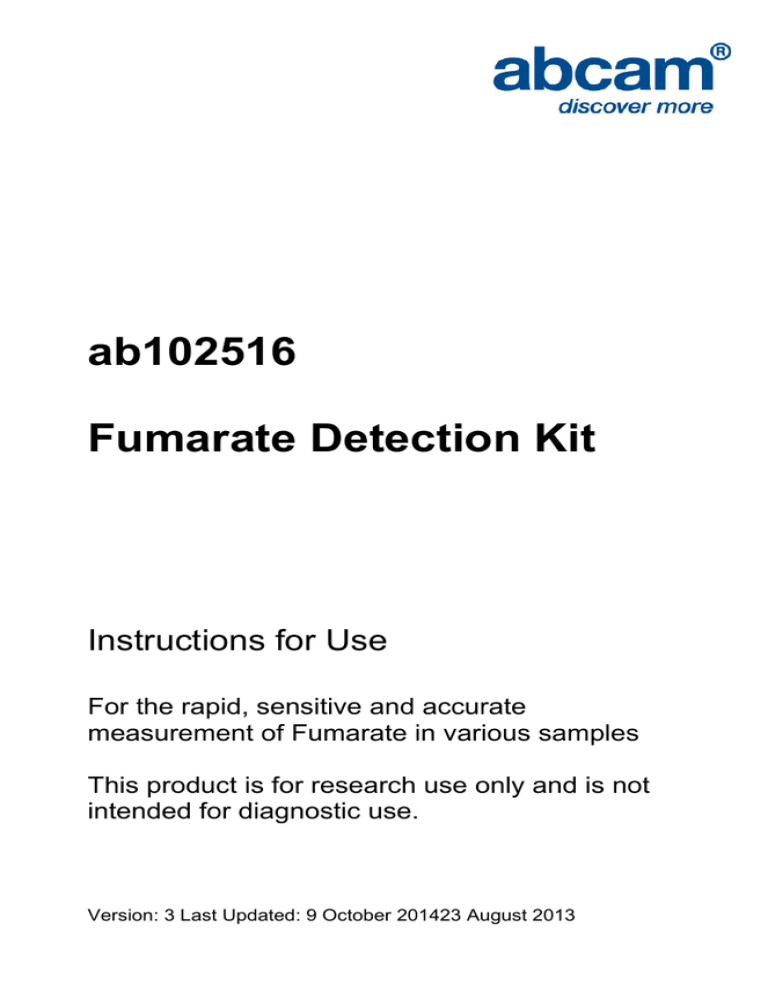
ab102516
Fumarate Detection Kit
Instructions for Use
For the rapid, sensitive and accurate
measurement of Fumarate in various samples
This product is for research use only and is not
intended for diagnostic use.
Version: 3 Last Updated: 9 October 201423 August 2013
1
Table of Contents
1.
Overview
3
2.
Protocol Summary
4
3.
Components and Storage
5
4.
Assay Protocol
7
5.
Data Analysis
9
6.
Troubleshooting
10
2
1. Overview
Fumarate (HO2CCH=CHCO2H-) is an intermediate in the Kreb’s
cycle used by cells to metabolize food to form ATP. In the
mammalian liver, Fumarate is also a product of the Urea cycle where
its release in the cytosol leads to its conversion into malate and
subsequently oxaloacetate while generating NADH in the cytosol.
The human skin naturally produces fumaric acid when exposed to
sunlight. In fact, fumaric acid esters have been used to treat
psoriasis, possibly due to an impaired production of fumaric acid in
the skin. Fumaric acid has also been used in beverages, baking
powders and candy.
Abcam’s Fumarate Detection Kit provides a convenient tool for
sensitive detection of the fumarate in a variety of samples. The
Fumarate Enzyme Mix recognizes fumarate as a specific substrate
leading to proportional color development. The amount of fumarate
can therefore be easily quantified using a colorimetric assay
(λ = 450 nm). It can detect as low as 1 nmol of fumarate per well
(20 µM).
3
2. Protocol Summary
Sample Preparation
Standard Curve Preparation
Prepare and Add Reaction Mix
Measure Absorbance
4
3. Components and Storage
A. Kit Components
Item
Quantity
Fumarate Assay Buffer
25 mL
Fumarate Enzyme Mix
1 vial
Fumarate Developer
1 vial
Fumarate Standard (0.1 M)
0.2 mL
* Store the kit at -20°C, protect from light. Allow Assay Buffer to
warm to room temperature before use. Briefly centrifuge small vials
before opening. Keep the Fumarate Enzyme Mix on ice during the
assay and protect from light. Read the entire protocol before
performing the assay.
FUMARATE ENZYME MIX: Reconstitute with 220 μl Assay Buffer.
Pipette up and down several times to completely dissolve the pellet
into solution (Don’t vortex). Aliquot enough Fumarate Enzyme Mix
(2 μl per assay) for the number of assays to be performed, aliquot
and freeze the stock solution immediately at -20°C for future use.
The Fumarate Enzyme Mix is stable for up to 2 months at -20°C after
reconstitution, but less than five freeze-thaw cycles.
5
FUMARATE DEVELOPER: Reconstitute with 0.9 ml of ddH2O.
Pipette up and down several times to completely dissolve the pellet
into solution (Don’t vortex).
B. Additional Materials Required
Microcentrifuge
Pipettes and pipette tips
Colorimetric microplate reader
96 well plate
Orbital shaker
6
4. Assay Protocol
1. Sample Preparation:
Tissues (40 mg) or cells (1×106) can be homogenized in the Assay
Buffer, centrifuge at 13,000 x g for 10 min to remove insoluble
materials. 10-50 μl serum samples can be directly diluted in the
Assay Buffer. Prepare samples up to 50 μl/well with Assay Buffer in
a 96-well plate. We suggest testing several doses of your sample to
make sure the readings are within the standard curve range.
Recommended input per well
Biological fluids: 25-50 µL
Cell lysates: 0.5x106
Cell culture supernatants: 10-50 µL
Tissue lysate (protein mass): 20-50 µg
2. Standard Curve Preparation:
Dilute 10 μl of the 0.1 M Fumarate standard with 990 μl Assay Buffer
to generate 1 mM Standard Fumarate. Add 0, 2, 4, 6, 8,10 μl of the
diluted Fumarate standard into a 96-well plate in duplicate. Adjust
volume to 50 μl/well with Assay Buffer to generate 0, 2, 4, 6,
8,10 nmol/well of the Fumarate Standard.
3. Reaction Mix:
Mix enough reagents for the number of assays to be performed. For
each well, prepare a total 100 μl Reaction Mix containing:
7
Fumarate Assay Buffer
90 μl
Fumarate Developer
8 μl
Fumarate Enzyme Mix
2 μl
4. Add 100 μl of the Reaction Mix to each well containing the
Fumarate Standard and test samples. Mix well. Incubate the reaction
for 60 min at 37°C, protect from light.
5. Measure the absorbance at 450nm in a microplate reader.
8
5. Data Analysis
Correct background by subtracting the value derived from the zero
Fumarate control from all sample readings. The background reading
can be significant and must be subtracted from sample readings.
Plot Fumarate standard curve. Fumarate concentrations of the test
samples can then be calculated:
Concentration = Sa / Sv (nmol/ml or μM)
Where:
Sa is the fumarate amount of sample (in nmol) from standard curve
Sv is sample volume (ml) added into the wells.
Fumaric acid, disodium salt, MW = 160.04 g/mol.
Fumarate Standard Curve performed according to Assay Protocol.
9
6. Troubleshooting
Problem
Reason
Solution
Assay not
working
Assay buffer at
wrong temperature
Assay buffer must not be chilled
- needs to be at RT
Protocol step missed
Plate read at
incorrect wavelength
Unsuitable microtiter
plate for assay
Unexpected
results
Re-read and follow the protocol
exactly
Ensure you are using
appropriate reader and filter
settings (refer to datasheet)
Fluorescence: Black plates
(clear bottoms);
Luminescence: White plates;
Colorimetry: Clear plates.
If critical, datasheet will indicate
whether to use flat- or U-shaped
wells
Measured at wrong
wavelength
Use appropriate reader and filter
settings described in datasheet
Samples contain
impeding substances
Unsuitable sample
type
Sample readings are
outside linear range
Troubleshoot and also consider
deproteinizing samples
Use recommended samples
types as listed on the datasheet
Concentrate/ dilute samples to
be in linear range
10
Samples
with
inconsistent
readings
Unsuitable sample
type
Samples prepared in
the wrong buffer
Samples not
deproteinized (if
indicated on
datasheet)
Cell/ tissue samples
not sufficiently
homogenized
Too many freezethaw cycles
Samples contain
impeding substances
Samples are too old
or incorrectly stored
Lower/
Higher
readings in
samples
and
standards
Not fully thawed kit
components
Out-of-date kit or
incorrectly stored
reagents
Reagents sitting for
extended periods on
ice
Incorrect incubation
time/ temperature
Incorrect amounts
used
Refer to datasheet for details
about incompatible samples
Use the assay buffer provided
(or refer to datasheet for
instructions)
Use the 10kDa spin column
(ab93349)
Increase sonication time/
number of strokes with the
Dounce homogenizer
Aliquot samples to reduce the
number of freeze-thaw cycles
Troubleshoot and also consider
deproteinizing samples
Use freshly made samples and
store at recommended
temperature until use
Wait for components to thaw
completely and gently mix prior
use
Always check expiry date and
store kit components as
recommended on the datasheet
Try to prepare a fresh reaction
mix prior to each use
Refer to datasheet for
recommended incubation time
and/ or temperature
Check pipette is calibrated
correctly (always use smallest
volume pipette that can pipette
entire volume)
11
Problem
Reason
Solution
Standard
curve is not
linear
Not fully thawed kit
components
Wait for components to thaw
completely and gently mix prior
use
Pipetting errors when
setting up the
standard curve
Incorrect pipetting
when preparing the
reaction mix
Air bubbles in wells
Concentration of
standard stock
incorrect
Errors in standard
curve calculations
Use of other
reagents than those
provided with the kit
Try not to pipette too small
volumes
Always prepare a master mix
Air bubbles will interfere with
readings; try to avoid producing
air bubbles and always remove
bubbles prior to reading plates
Recheck datasheet for
recommended concentrations of
standard stocks
Refer to datasheet and re-check
the calculations
Use fresh components from the
same kit
For further technical questions please do not hesitate to
contact us by email (technical@abcam.com) or phone (select
“contact us” on www.abcam.com for the phone number for
your region).
12
13
14
UK, EU and ROW
Email: technical@abcam.com | Tel: +44(0)1223-696000
Austria
Email: wissenschaftlicherdienst@abcam.com | Tel: 019-288-259
France
Email: supportscientifique@abcam.com | Tel: 01-46-94-62-96
Germany
Email: wissenschaftlicherdienst@abcam.com | Tel: 030-896-779-154
Spain
Email: soportecientifico@abcam.com | Tel: 911-146-554
Switzerland
Email: technical@abcam.com
Tel (Deutsch): 0435-016-424 | Tel (Français): 0615-000-530
US and Latin America
Email: us.technical@abcam.com | Tel: 888-77-ABCAM (22226)
Canada
Email: ca.technical@abcam.com | Tel: 877-749-8807
China and Asia Pacific
Email: hk.technical@abcam.com | Tel: 108008523689 (中國聯通)
Japan
Email: technical@abcam.co.jp | Tel: +81-(0)3-6231-0940
www.abcam.com | www.abcam.cn | www.abcam.co.jp
15
Copyright © 2014 Abcam, All Rights Reserved. The Abcam logo is a registered trademark.
All information / detail is correct at time of going to print.


![Anti-DR4 antibody [B-N28] ab59481 Product datasheet Overview Product name](http://s2.studylib.net/store/data/012243732_1-814f8e7937583497bf6c17c5045207f8-300x300.png)
